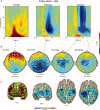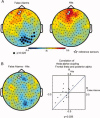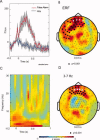Prestimulus alpha and mu activity predicts failure to inhibit motor responses
- PMID: 19308934
- PMCID: PMC6870709
- DOI: 10.1002/hbm.20763
Prestimulus alpha and mu activity predicts failure to inhibit motor responses
Abstract
Do certain brain states predispose humans to commit errors in monotonous tasks? We used MEG to investigate how oscillatory brain activity indexes the brain state in subjects performing a Go-noGo task. Elevated occipital alpha and sensorimotor mu activity just prior to the presentation of the stimuli predicted an upcoming error. An error resulted in increased frontal theta activity and decreased posterior alpha activity. This theta increase and alpha decrease correlated on a trial-by-trial basis reflecting post-error functional connectivity between the frontal and occipital regions. By examining the state of the brain before a stimulus, we were able to show that it is possible to predict lapses of attention before they actually occur. This supports the case that the state of the brain is important for how incoming stimuli are processed and for how subjects respond.
(c) 2009 Wiley-Liss, Inc.
Figures




References
-
- Ahonen AI,Hamalainen MS,Ilmoniemi RJ,Kajola MJ,Knuutila JE,Simola JT,Vilkman VA ( 1993): Sampling theory for neuromagnetic detector arrays. IEEE Trans Biomed Eng 40: 859–869. - PubMed
-
- Bastiaansen MC,Knosche TR ( 2000): Tangential derivative mapping of axial MEG applied to event‐related desynchronization research. Clin Neurophysiol 111: 1300–1305. - PubMed
-
- Bokura H,Yamaguchi S,Kobayashi S ( 2001): Electrophysiological correlates for response inhibition in a Go/NoGo task. Clin Neurophysiol 112: 2224–2232. - PubMed
-
- Bray S,O'Doherty J ( 2007): Neural coding of reward‐prediction error signals during classical conditioning with attractive faces. J Neurophysiol 97: 3036–3045. - PubMed
Publication types
MeSH terms
LinkOut - more resources
Full Text Sources
Other Literature Sources
Research Materials

